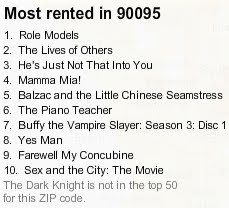Compare the list shown above to zip code 90095 shown at right, which is for West Hollywood -an outspoken gay and lesbian community. Half the movies on the 90095 list are several years old and were embraced by the Hollywood crowd as artistic and expressive while the movies listed in the 92835 zip code tend to be characterized as season blockbusters.
I'm not sure exactly what inferences can be made by these lists but I think it is quite evident that communities differ widely even when separated by just a few miles.
You see the same separation in movie titles in the San Francisco Bay area. Metro SF Bay sees Milk as the most popular rental while just northwest across the bay Milk isn't even in the top 10 list! Use the link in the title to visit the Times and see if you find some interesting trends. Report back; I'm curious what you might be able to guess about a neighborhood or community based simply on movie titles rented.


I heard about this some time ago. Here's an excerpt from an article in Open Salon dot com.
ReplyDeleteThis article features two of my favorite things in the whole world: 1) Pointing out the hypocrisy of social conservatives and 2) independent research.
Benjamin Edelman, who works at Harvard Business School and part-time as a consultant preventing credit card fraud for AOL along with an "adult entertainment trade publication" that took in $2. 8 billion dollars in revenue in 2006, had access to two years' worth of thousands of credit cards--and their associated postal codes. Curious, he decided to study these postal codes to see which states consume the most porn, and any other differences in porn subscriptions. Naturally, he controlled for broadband access and population, and although he found that there wasn't that much variation between states, there was enough to conclude that the states that tended to be the most religious--and, as reflected in the policies of those states, the most anti-gay--also had the highest average numbers of online porn subscriptions per capita.
You can read the rest at:
http://open.salon.com/blog/jessabelle/2009/02/27/conservative_christians_forinternet_porn
Pornography in those more conservative areas is by nature a clandestine endeavor where as in the more liberal areas, who would need a subscription? (rhetorical question) The more liberal states and communities have an abundance of pornography in their neighborhood stores.
ReplyDeleteOther key points to consider include the fact that Netflix doesn't rent pornography, or at least not when I had a subscription. Also, the GIS information is looking at it on a much more local level ONLY IN METROPOLITAN AREAS.
So, although it may seem scandalous that the bible belt has more pornography purchases than the more densely populated metropolitan and thus liberal communities says little about the nature of neighborhood politics - the point of my post.